PCC overlays of existing rigid pavements have been used for years to restore pavement structural capacity. All types of rigid pavement designs (JPCP, JRCP, CRCP) are appropriate to be overlaid and to be used as overlays. This section briefly describes the AASHTO design procedure for the two major types of PCC overlays: unbonded and bonded.
Unbonded
An unbonded PCC overlay consists of a relatively thick PCC layer (typically 125 – 305 mm (5 – 12 inches) thick) over an existing rigid pavement. Bonding between the existing pavement and overlay is intentionally prevented by using a slurry seal, BST, or HMA bond breaking interlayer. This intentional separation allows the original pavement and overlay to act independently of each other and helps prevent distresses in the existing pavement from reflecting through into the overlay (ACPA, 2001[1]). Unbonded overlays are generally used as an alternative to rubblization when the existing rigid pavement is badly deteriorated. Their primary advantages are that they (1) can be applied over a badly deteriorated pavement without much surface preparation and (2) they do not require the existing pavement to be removed. Their primary disadvantages are (1) because they are relatively thick and placed directly over the existing pavement, they add substantially to roadway elevation, which could pose overhead clearance problems, and (2) they are relatively expensive.
Structural Design
The design procedure contained in the 1993 AASHTO Guide is virtually identical to the AASHTO empirical design for new rigid pavements with one exception: The effective modulus of subgrade reaction (k) is determined based on the existing pavement resilient modulus. Although perfectly acceptable, this method gives little credit to the existing pavement’s remaining strength. The basic equation in the 1993 AASHTO Guide is:
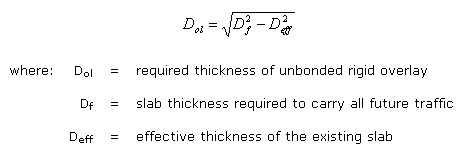
The 1993 AASHTO Guide design procedure is summarized below.
- Determine the slab thickness required to carry all future traffic (Df). This is done as it would be in the normal AASHTO empirical design process for new rigid pavements. Material properties used in these calculations should be those of the overlay material and not the existing rigid pavement. Other values, are specified in the 1993 AASHTO Guide.
- Determine the effective thickness of the existing slab (Deff) by one of the following two methods:
From a condition survey. The following equation is used to adjust the actual existing slab thickness based on condition survey results:
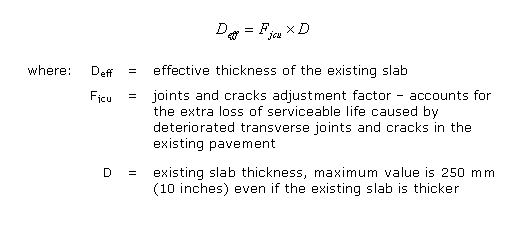
From a remaining life calculation. This method does not account for any benefits from pre-overlay repair. The following equation is used to determine the remaining life as a percentage of total life:
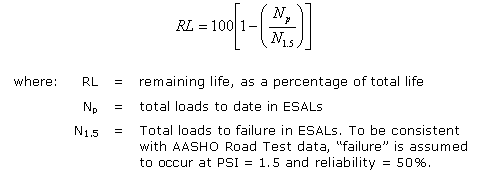
Joint Design
Joints are typically designed to be mismatched with underlying existing joints. The assumption is that the thick overlay and bond breaking interlayer will prevent reflective cracking, therefore mismatching the joints will improve load transfer. AASHTO recommends that “the placement of joints in the overlay should be mismatched from existing joints and working cracks by at least 0.9 m (3 ft.) where possible” (AASHTO, 1990[2]).
Bonded
A bonded PCC overlay consists of a relatively thin PCC layer (typically less than 100 mm (4 inches) thick) over an existing rigid pavement. The overlay is intentionally bonded to the existing pavement with a PCC slurry or grout in order to create a composite pavement section (McGhee, 1994[3]). Bonded overlays are generally used to add structural capacity to existing rigid pavements that have little deterioration (e.g., no faulting or spalling and cracked slabs should be replaced before overlay). Their primary advantages are that they (1) are thinner than unbonded overlays and (2) their structural design accounts for the strength of the underlying pavement. Their primary disadvantages are (1) they should not be applied over badly distressed pavements because the distress may affect bond quality, and (2) they are dependent upon good bond development – if for some reason this does not occur, the pavement could be structurally inadequate.
Structural Design
The design procedure in the 1993 AASHTO Guide is somewhat similar to that for unbonded overlays, however, it is more dependent on existing pavement characteristics. Specifically, there are three key differences:
- The overlay thickness is a linear function of the total required slab thickness (Df) and effective slab thickness (Deff) instead a quadratic function. This results in a thinner overlay for a given Df and Deff. In essence, the bonded overlay design procedure gives more credit to the existing pavement’s structural contribution.
- Design is based on the material properties of the existing pavement structure because of the expected bonding.
- Effective thickness (Deff) calculations incorporate more aspects of the existing pavement’s structure. Because the design relies more heavily on the existing pavement’s structure, it’s evaluation should be more rigorous.
The basic equation in the 1993 AASHTO Guide is:

The 1993 AASHTO Guide design procedure is summarized below.
- Determine the existing pavement structure and material properties. This includes determining the existing slab thickness, type of load transfer, type of shoulder design (flexible or rigid), condition survey, effective modulus of subgrade reaction (k), PCC parameters (elastic modulus, modulus of rupture), joint load transfer, etc.
- Determine the slab thickness required to carry all future traffic (Df). This is done as it would be in the normal AASHTO empirical design process for new rigid pavements. Material properties used in these calculations should be those of the existing material and not the overlay. Other values, are specified in the 1993 AASHTO Guide.
- Determine the effective thickness of the existing slab (Deff) by one of the following two methods:
From a condition survey. The following equation is used to adjust the actual existing slab thickness based on condition survey results:
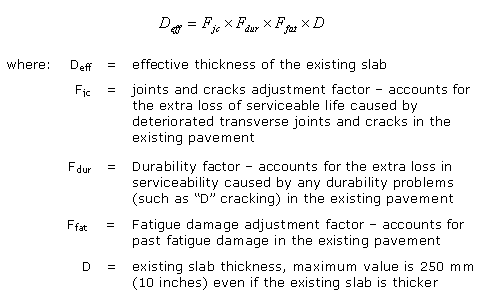
From a remaining life calculation. This method does not account for any benefits from pre-overlay repair. The following equation is used to determine the remaining life as a percentage of total life:
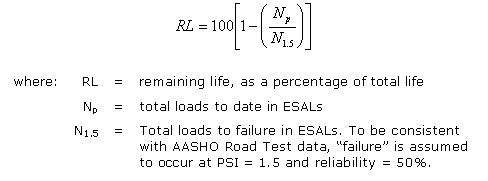
Joint Design
Joints are typically designed to coincide with underlying existing joints, otherwise uncontrolled reflective cracking may occur and substantially affect overlay performance (McGhee, 1994[3]). Dowels and reinforcing steel are generally not placed in the overlay joints.
- American Concrete Pavement Association (ACPA). (2001). Concrete Types. Web page on the American Concrete Pavement Association’s web site. Accessed 18 January 2002.↵
- American Association of State Highway and Transportation Officials (AASHTO). (1990). Guide Specifications for Concrete Overlays of Pavements and Bridge Decks. The AASHTO – Associated General Contractors of America – American Road & Transportation Builders Assocation Joint Committee, Subcommittee on New Highway Materials. American Association of State Highway and Transportation Officials. Washington, D.C.↵
- McGhee, K.H. (1994). National Cooperative Highway Research Program Synthesis of Highway Practice 204: Portland Cement Concrete Resurfacing. Transportation Research Board, National Research Council. Washington, D.C.↵
